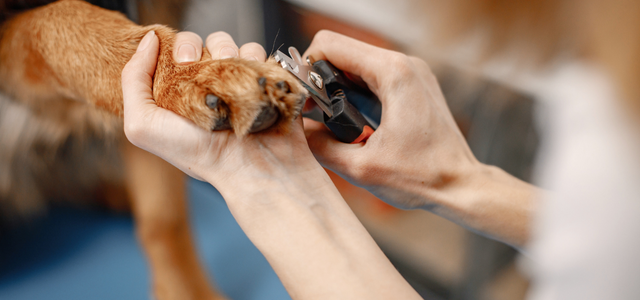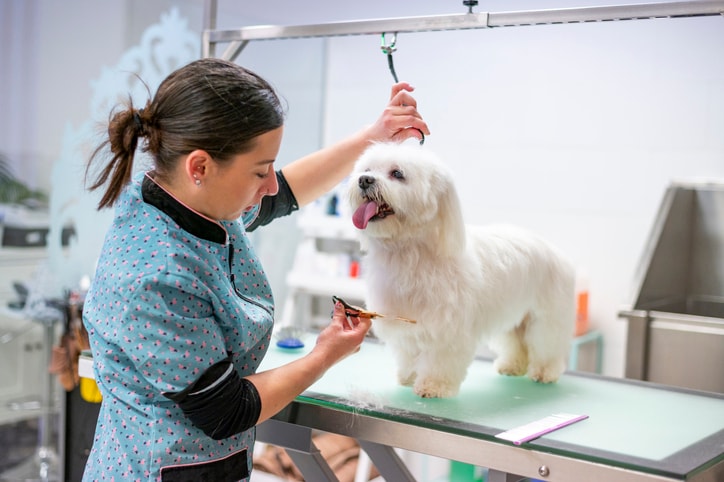Full Grooming Routine for Dogs
May 27, 2024
Grooming isn't just about aesthetics; it's responsible pet ownership! Grooming offers various benefits that extend beyond just keeping your furry friend looking their best. Understanding the significance of grooming goes hand in hand with ensuring the overall well-being of your beloved canine companion.
One of the often-overlooked benefits of regular grooming is the opportunity it provides for early detection of potential health issues. During grooming sessions, you have the chance to thoroughly inspect your dog's skin, coat, ears, eyes, and other areas for any signs of abnormalities. Lumps, bumps, rashes, or changes in skin texture can be indicative of underlying health issues that may require veterinary attention.
Table of Contents
Full Grooming Routine for Dogs
Below you’ll find a full grooming routine so you can keep your dog looking and feeling their best at home.
Brushing
Regular brushing is the foundation of any dog grooming routine. It not only helps to keep your dog's coat looking neat and tidy but also plays a crucial role in their overall skin and coat health. The frequency of brushing depends on your dog's breed, coat type, and length.
Long-haired breeds may require daily brushing to prevent mats and tangles, while short-haired breeds may only need brushing a few times a week. When selecting a brush, consider your dog's coat type—slicker brushes work well for long, thick coats, while bristle brushes are suitable for shorter coats.
Bathing
Bathing your dog is another essential aspect of their grooming routine, but it's important not to overdo it. The frequency of baths should be based on your dog's individual needs, taking into account factors such as coat type, activity level, and skin condition.
Generally, most dogs only need to be bathed every 4 to 6 weeks to avoid stripping their coat of its natural oils. When bathing your dog, use a dog-specific shampoo that is gentle on their skin and free from harsh chemicals. Thoroughly rinse your dog's coat to remove all traces of shampoo, as leftover residue can irritate their skin.
Nail Trimming

Regular nail maintenance is essential for your dog's comfort and mobility. Overgrown nails can cause discomfort and even lead to health issues such as ingrown nails or joint problems. The frequency of nail trimming depends on your dog's activity level and environment but generally ranges from every 2 to 6 weeks. Use sharp, high-quality nail clippers designed specifically for dogs to ensure a clean cut and minimize discomfort.
When trimming your dog's nails, be cautious not to cut too close to the quick, which contains blood vessels and nerves. If you're unsure about nail trimming or your dog has black nails, which make it challenging to see the quick, consider seeking professional help from a groomer or veterinarian.
Ear Cleaning
Regular ear cleaning is important for preventing ear infections and maintaining your dog's overall ear health. Check your dog's ears regularly for signs of dirt, wax buildup, redness, or odor, which may indicate an infection. Use a dog-specific ear cleaner and cotton balls or pads to gently wipe the outer part of your dog's ears, avoiding inserting anything into the ear canal.
Be careful not to push debris further into the ear, as this can cause discomfort or injury. If you notice any abnormalities or your dog shows signs of ear discomfort, such as excessive scratching or head shaking, consult your veterinarian for further evaluation and treatment.
Dental Care
Oral hygiene is often overlooked but is essential for your dog's overall health and well-being. Just like humans, dogs can suffer from dental issues such as tartar buildup, gum disease, and tooth decay if their teeth are not properly cared for. Establish a regular dental care routine that includes brushing your dog's teeth with a dog-specific toothbrush and toothpaste.
Aim to brush your dog's teeth at least 2 to 3 times a week to remove plaque and prevent tartar buildup. In addition to brushing, provide your dog with dental chews, toys, or treats that are specifically designed to promote oral health and reduce plaque and tartar buildup.
Advanced Grooming Techniques
These techniques require precision, patience, and sometimes professional assistance to ensure your dog's grooming experience is as comfortable and effective as possible.
Styling and Trimming

Different dog breeds have unique grooming requirements and signature styles that accentuate their appearance. Whether it's the intricate patterns of a Poodle's coat or the sleek lines of a Shih Tzu's trim, breed-specific grooming styles require careful attention to detail.
Consulting with professional groomers or utilizing online resources can provide valuable guidance on achieving these desired looks. Investing in the right tools, such as grooming shears and clippers, is essential for executing precise cuts and styles that enhance your dog's natural beauty.
Anal Gland Expression
While it may not be the most pleasant aspect of grooming, expressing your dog's anal glands is vital for their comfort and health. These small glands located near the anus produce secretions that help with scent marking and lubricating the stool during elimination. However, if these glands become impacted or infected, they can cause discomfort and even lead to serious health issues.
Signs indicating the need for expression include scooting, licking, or signs of discomfort when sitting. If you're uncomfortable with performing anal gland expression yourself, it's best to seek professional assistance from a veterinarian or groomer to ensure it's done safely and effectively.
Paw Care
Your dog's paws play a crucial role in their mobility and comfort, making paw care an essential part of their grooming routine. Regularly inspect your dog's paws for foreign objects, such as rocks or thorns, that may cause discomfort or injury. Trim excess hair around the paw pads to prevent slipping and matting, especially in breeds with long fur between the toes.
Keeping your dog's paw pads clean and trimmed reduces the risk of injuries and ensures they can walk and run comfortably. Additionally, providing your dog with paw balm or moisturizer can help protect their paw pads from dryness and cracking, particularly in harsh weather conditions.
Wrapping Up
Grooming is a journey—a process of learning and growth for both you and your dog. As you navigate different grooming techniques and adapt to your dog's evolving needs, remember that it's okay to seek help when needed and to embrace the learning experience.
We encourage you to approach grooming not just as a task but as an opportunity to nurture your relationship with your dog and to ensure their overall well-being. By prioritizing your dog's grooming routine, you're making a commitment to their health, happiness, and quality of life.
